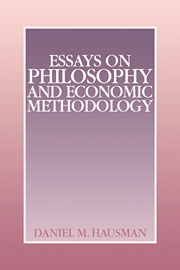Book contents
- Frontmatter
- Contents
- Introduction: What is philosophy of economics?
- PART I METHODOLOGY AND THEORY APPRAISAL
- 1 Economic methodology in a nutshell
- 2 On the conceptual structure of neoclassical economics – a philosopher's view
- 3 John Stuart Mill's philosophy of economics
- 4 The deductive method
- 5 Why look under the hood?
- 6 An appraisal of Popperian methodology
- 7 Is falsificationism unpractised or unpractisable?
- 8 The limits of economic science
- PART II CAUSALITY IN ECONOMICS
- PART III CASES AND PUZZLES
- PART IV POSTSCRIPTS
- Bibliography of relevant writings by Daniel M. Hausman
- Bibliography of works by other authors
- Index
2 - On the conceptual structure of neoclassical economics – a philosopher's view
Published online by Cambridge University Press: 05 June 2012
- Frontmatter
- Contents
- Introduction: What is philosophy of economics?
- PART I METHODOLOGY AND THEORY APPRAISAL
- 1 Economic methodology in a nutshell
- 2 On the conceptual structure of neoclassical economics – a philosopher's view
- 3 John Stuart Mill's philosophy of economics
- 4 The deductive method
- 5 Why look under the hood?
- 6 An appraisal of Popperian methodology
- 7 Is falsificationism unpractised or unpractisable?
- 8 The limits of economic science
- PART II CAUSALITY IN ECONOMICS
- PART III CASES AND PUZZLES
- PART IV POSTSCRIPTS
- Bibliography of relevant writings by Daniel M. Hausman
- Bibliography of works by other authors
- Index
Summary
In this chapter I shall discuss two related philosophical issues concerning economics (see Hausman 1981b, chs. 3, 6). First, what is the nature and the significance of models in economics? Why does nearly all theoretical work take the form of (unrealistic) model building? How are such models related to things such as laws and theories which are more familiar to philosophers? Second, what is the fundamental theory or model of neoclassical economics? How is that fundamental theory or model related to specific neoclassical theories or models? What is the unit of appraisal of neoclassical economics? I hope to sketch in broad strokes a conceptual map of fundamental neoclassical theory – to provide a consistent and sensible way of seeing the whole enterprise – that is congruent with the actual practices of economics.
WHAT ARE MODELS AND WHY ARE THEY SO IMPORTANT IN ECONOMICS?
The models that economists employ should be regarded as complex predicates or concepts or as definitions of such complex predicates or concepts. A model is of the same logical kind as a predicate, such as “is triangular,” or as a definition of what it is to be triangular. One thus does not test a model, nor does one say that a model is true (except perhaps in the trivial way in which a definition is true). This is not, of course, to deny that one can use models to make claims about the world which may be tested and which may be true or false.
- Type
- Chapter
- Information
- Essays on Philosophy and Economic Methodology , pp. 25 - 32Publisher: Cambridge University PressPrint publication year: 1992
- 1
- Cited by



